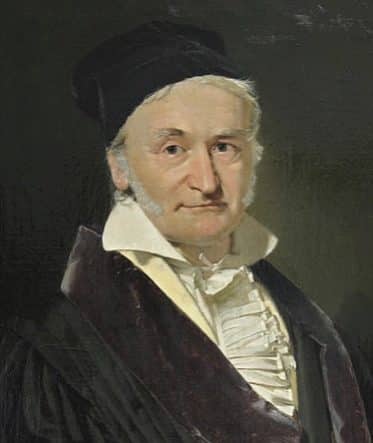
People who are described as geniuses in mathematics or theoretical physics were often precocious and their gifts were recognized early. The quintessential mathematical genius in the 18th century, was Karl Friedrich Gauss. He was a calculating prodigy, whose remarkable gifts emerged when he was 3 years old, enabling him to perform long and intricate computations in his head and emerge with the correct answer at remarkable speed. When he was 15 years old, Carl anticipated the Prime Number Theorem asserting the number of prime numbers less than the integer n is approximately n/log n as n becomes large. By age 18 he had developed a theory of errors in measurement. Out of this work, the ubiquitous normal distribution and the method of least squares emerged, eventually becoming an indispensable tool of statistics. About this time, he also discovered the conditions under which a polygon of n sides is constructible with ruler and compasses. At the age of 22, Gauss proved the Fundamental Theorem of Algebra asserting that a polynomial of degree n has n zeros in the complex plane.
Our 19th century mathematical genius, William Rowan Hamilton, was born on August 4, 1805 in Dublin, Ireland. The fourth of nine children, he was sent at age three to live with his uncle James Hamilton, who observed that William, from an early age, had displayed a special proclivity for languages. By age 13 he had acquired, through his uncle’s tutelage, some degree of fluency in about a dozen Indo-European languages.
By the time he was 16 years old, William had mastered most of Newton’s Principia, having already absorbed Newton’s Arithmetica Universalis. By age 18, Hamilton was accepted at Trinity College in Dublin, subsequently scoring the top grade in every subject in every year achieving a BA degree in both classics and mathematics in 1827. In that year, at the age of 22, he was appointed, over other highly-esteemed astronomers, Andrews Professor of Astronomy and Royal Astronomer of Ireland.
Around 1832, when William was 27 years of age, he formulated his theory of rays that provided a foundation for the study of light and optics. From this theory, he predicted that a single ray of light within a biaxial crystal must, in certain cases, yield a cone of refracted rays–a phenomenon known as conical refraction. When his prediction was verified by observation, his formulation of optics became a basis for other mathematical models describing the behavior of waves. A century later, his mathematical operators would be used in quantum physics to provide a wave-mechanical description of particles. In 1835, Hamilton was knighted and became Sir William Rowan Hamilton.
Our 20th century mathematical genius is Terence Tao, who was born on July 17, 1975, in Adelaide, Australia. From an early age, he displayed exceptional mathematical abilities and was considered a child prodigy. By the age of 14, he had become the youngest gold medalist in the history of the International Mathematical Olympiad (IMO).
Tao pursued his undergraduate studies at Flinders University in Adelaide, earning his bachelor’s degree in mathematics at the age of 16. He then enrolled at the University of Adelaide for his doctoral studies, completing his Ph.D. in mathematics at the age of 21 under the supervision of Professor Garth Gaudry.
After completing his Ph.D., Tao held various positions at prestigious institutions around the world. He has served as a postdoctoral fellow at Princeton University, a Clay Research Fellow at the Massachusetts Institute of Technology (MIT), and a professor at the University of California, Los Angeles (UCLA). He currently holds the position of James and Carol Collins Chair in Mathematics at UCLA.
In 2006, Tao became the first Australian mathematician to receive the Fields Medal, widely considered the Nobel Prize of mathematics. He received this prestigious award for his groundbreaking contributions to partial differential equations, combinatorics, and harmonic analysis. He is particularly known for his work on the distribution of prime numbers, which has garnered international recognition.
Table 5.1 from Intelligence, IQ & Perception shows the ages at which top mathematicians achieved their famous breakthroughs.
Usually, a mathematical breakthroughs occur in their late 20’s and early 30’s, but recently, people require so much background to master the intricacies of a field that the preparation period for a breakthrough idea is protracted. In other words, “start very early, and learn as much as you can, before your fluid intelligence begins to decline.”
